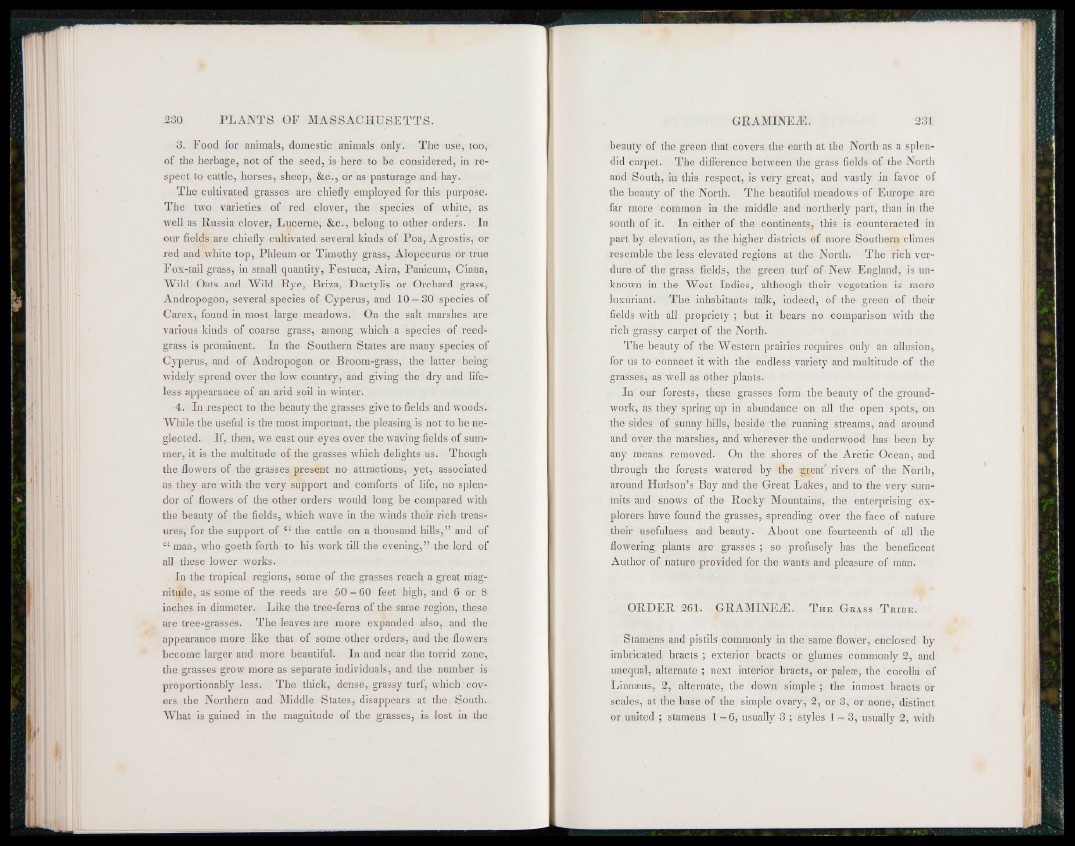
3. Food for animals, domestic animals only. The use, too,
of the herbage, not of the seed, is here to be considered, in respect
to cattle, horses, sheep, &c., or as pasturage and hay.
The cultivated grasses are chiefly employed for this purpose.
The two varieties of red clover, the species of white, as
well as Russia clover, Lucerne, &c., belong to other orders.- In
our fields are chiefly cultivated several kinds of Poa, Agrostis, or
red and white top, Phleum or Timothy grass, Alopecurus or true
Fox-tail grass, in small quantity, Festuca, Aira, Panicum, Cinna,
Wild Oats and Wild Rye, Briza, Dactylis or Orchard grass,
Andropogon, several species of Cyperus, and 10 — 30 species of
Carex, found in most large meadow's. On the salt marshes are
various kinds of coarse grass, among which a species of reed-
grass is prominent. In the Southern States are many species of
Cyperus, and of Andropogon or Broom-grass, the latter being
widely spread over the low country, and giving the dry and lifeless
appearance of an arid soil in winter.
4. In respect to the beauty the grasses give to fields and woods.
While the useful is the most important, the pleasing is not to be neglected.
If, then, we cast our eyes over the waving fields of summer,
it is the multitude of the grasses which delights us. Though
the flowers of the grasses present no attractions, yet, associated
as they are with the very support and comforts of life, no splendor
of flowers of the other orders would long be compared with
the beauty of the fields, which wave in the winds their rich treasures,
for the support of c‘ the cattle on a thousand hills,” and of
u man, who goeth forth to his work till the evening,” the lord of
all these lower works.
In the tropical regions, some of the grasses reach a great magnitude,
as some of the reeds are 50 - 60 feet high, and 6 or 8
inches in diameter. Like the tree-ferns of the same region, these
are tree-grasses. The leaves are more expanded also, and the
appearance more like that of some other orders, and the flowers
become larger and more beautiful. In and near the torrid zone,
the grasses grow more as separate individuals, and the number is
proportionably less. The thick, dense, grassy turf, which covers
the Northern and Middle States, disappears at the South.
What is gained in the magnitude of the grasses, is lost in the
beauty of the green that covers the earth at the North as a splendid
carpet. The difference between the grass fields of the North
and South, in this respect, is very great, and vastly in favor of
the beauty of the North. The beautiful meadows of Europe are
far more common in the middle and northerly part-, than in the
south of it. In either of the continents, this is counteracted in
part by elevation, as the higher districts of more Southern climes
resemble the less elevated regions at the North. The rich verdure
of the grass fields, the green turf of New England, is unknown
in the West Indies, although their vegetation is more
luxuriant. The inhabitants talk, indeed, of the green of their
fields with all propriety ; hut it bears no comparison with the
rich grassy carpet of the North.
The beauty of the Western prairies requires only an allusion,
for us to connect it with the endless variety and multitude of the
grasses} as well as other plants.
In our forests, these grasses form the beauty of the groundwork,
as they spring up in abundance on all the open spots, on
the sides of sunny hills, beside the running streams, and around
and over the marshes, and wherever the underwood has been by
any means removed. On the shores of the Arctic Ocean, and
through the forests watered by the great' rivers of the North,
around Hudson’s Bay and the Great Lakes, and to the very summits
and snows of the Rocky Mountains, the enterprising explorers
have found the grasses, spreading over the face of nature
their usefulness and beauty. About one fourteenth of all the
flowering plants are grasses ; so profusely has the beneficent
Author of nature provided for the wants and pleasure of man.
ORDER 261. GRAMINEjE . T he G rass T r ib e .
Stamens and pistils commonly in the same flower, enclosed by
imbricated bracts ; exterior bracts or glumes commonly 2, and
unequal, alternate ; next interior bracts, or paleae, the corolla of
Linnaeus, 2, alternate, the down simple ; the inmost bracts or
scales, at the base of the simple ovary, 2, or 3, or none, distinct
or united ; stamens 1 -6 , usually 3 ; styles 1 — 3, usually 2, with